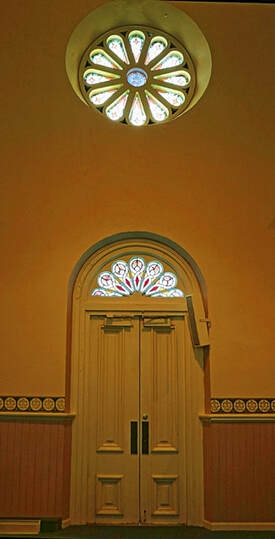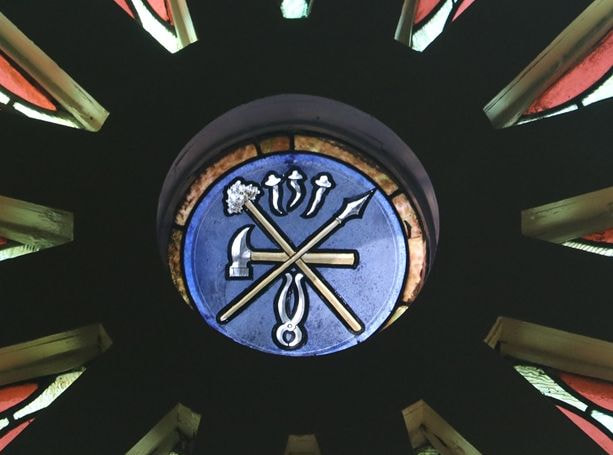16. Outside Doors With Rosette Window Above.
The main window in the #16 position is a round rosette that measures about 70" in diameter. The rosette is above an exterior, double-door that has its own arched stained-glass window. These windows were not donated by parishioners. But for our older older parishioners, the doors still have a special meaning.
The main window in the #16 position is a round rosette that measures about 70" in diameter. The rosette is above an exterior, double-door that has its own arched stained-glass window. These windows were not donated by parishioners. But for our older older parishioners, the doors still have a special meaning.
 Photo and Banner Photo - R. Brogan
Photo and Banner Photo - R. Brogan
The doors beneath the west rosette window evoke memories from our Passionist era. The Passionist monastery was attached to the northwest corner of the church. Its entry was a short distance from those double doors. During many Masses or Benediction services those doors opened and a solemn procession entered the church. The procession was made up of forty or more dark-robed Passionist brothers and novitiates. They slowly entered the door with heads bowed and hands reverently folded as they walked down the west aisle to the winding choir loft staircase.
As they walked to the choir loft they sang; and Oh My could they sing! During special Masses, such as Easter or Christmas, the procession might encircle the church, with the Blessed Sacrament carried beneath the pole-canopy, and the sound of their voices resounded throughout the large, cathedral ceilinged, stone building before they went upstairs. They sang in Latin. We didn’t know what it meant. But we knew that the power of their voices discriminated them from anyone or anything we had ever heard.
We had our own version of the Vatican choir right here in St. Paul, USA and we didn't understand how special it was until we lost it.
As they walked to the choir loft they sang; and Oh My could they sing! During special Masses, such as Easter or Christmas, the procession might encircle the church, with the Blessed Sacrament carried beneath the pole-canopy, and the sound of their voices resounded throughout the large, cathedral ceilinged, stone building before they went upstairs. They sang in Latin. We didn’t know what it meant. But we knew that the power of their voices discriminated them from anyone or anything we had ever heard.
We had our own version of the Vatican choir right here in St. Paul, USA and we didn't understand how special it was until we lost it.
|
A Sample of Our Passionist Experience:
About ten years ago one of the former Passionist novices visited St. Paul. Steve George was a member of the novitiate class of 1965; and he was among the last students. The novitiate closed in 1966. Steve left St. Paul with his class but was not ordained. He went on to become a web developer but always maintained a strong interest in the church, the Passionists and his time as a seminarian. One of his passions was collecting and producing sacred music and Gregorian Chants as animated YouTube videos. A sample is provided at the right. See Note 1 for more information about Steve and his large collection of chants. |
|
|
Some Reference Information:
1. Some links about the Passionist era in St. Paul:
|

